- Home
- Peter Ackroyd
Venice Page 11
Venice Read online
Page 11
An eighteenth-century watercolour of a Venetian nobleman patronising a café. Venice has always been more famous for its cafés than for its restaurants. In the eighteenth century they were calculated to number two hundred, with thirty-five in Saint Mark’s Square itself. The customers enjoyed cups of coffee and cups of chocolate, or glasses of lemonade and syrup. (photo credit i4.6)
A fresco painted by Giandomenico Tiepolo, at the end of the eighteenth century, showing Pulcinella disporting with acrobats. Pulcinella was a character from commedia dell’arte, the characteristic Venetian entertainment that first emerged in the sixteenth century, growing ever wilder and more obscene over the centuries. He wore a white costume and a black mask, and was well known for his long nose. In England he became known as Punch. (photo credit i4.7)
A pen and ink sketch, from the eighteenth century, showing three masked figures in Carnival costume. The Carnival was instituted at the end of the eleventh century, and has continued without interruption for almost seven hundred years. By the eighteenth century, at the very latest, the masks had become indispensable. Even the beggars wore masks. (photo credit i4.8)
Canaletto’s painting A Regatta on the Grand Canal. The regatta was an annual event, at the time of the Carnival, watched eagerly by all Venetians; it was formally instituted in the fourteenth century, and has continued ever since. This painting shows the one-oared light gondola race. (photo credit i4.9)
A painting of a masked ball taking place in Saint Mark’s Square during the Carnival. John Evelyn, the seventeenth-century English diarist, described such events as part of the “universal madnesse” with “the Women, Men & persons of all Conditions disguising themselves in antique dresses & extravagant Musique & a thousand gambols.” (photo credit i4.10)
A painting by Gabriele Bella showing a battle with sticks on a Venetian bridge. It was known as la guerra dei pugni or the war of the fists, fought between the inhabitants of the various territories and neighbourhoods. A team from each of these territories met for battle on a chosen bridge, while thousands of spectators lined the streets and houses beside the canal. It was a glorified fist-fight in which the object was to hurl opponents into the water and to gain possession of the bridge. (photo credit i4.11)
A game of bowls in the Campo dei Gesuiti, painted by Gabriele Bella in the eighteenth century. The square or campo was at the heart of the neighbourhood. It spread before the parish church and was once its burial ground. It was a self-contained entity, marked out by its well and carved well-head where the women of the parish came to gossip. It was a Venice in miniature. (photo credit i4.12)
An etching of the Bridge of Sighs, that led from the ducal palace to the ducal prisons. It was named after the laments of those about to be gaoled, and is the most picturesque of all penitential emblems. It was not in fact given that name until the nineteenth century; yet it serves the purpose, and the image, of Venice very well. (photo credit i4.13)
The front cover of Casanova by René Jeanne, published in 1927. Jacques Casanova is the most famous of all Venice’s favourite sons. He is the quintessential Venetian, and his memoirs demonstrate the facility with which life in the city can be turned into self-conscious and self-serving drama. “The chief business of my life has always been to indulge my senses,” he wrote. “I never knew anything of greater importance.” This might be justifiably described as a main article of the Venetian creed. (photo credit i4.14)
A poster advertising the Eastern Railway travelling from Paris to Venice at the end of the nineteenth century. The Grand Tour had given way to upper-middle-class travel with Venice as the most desirable destination of all. By the 1840s tourist guides to the city were being written; the first “Cook’s tour” of Venice was arranged in 1864. “The Venice of today,” Henry James wrote, “is a vast museum where the little wicket that admits you is perpetually turning and creaking …” (photo credit i4.15)
10
The Prison House
When Byron apostrophised Venice in the fourth canto of Childe Harold’s Pilgrimage, his tone was ambiguous:
I stood in Venice, on the Bridge of Sighs;
A palace and a prison on each hand …
He did not know, or failed to recollect, that the palace itself also contained a prison. An American visitor in 1760, James Adams, was appalled and discomfited by the atmosphere of the city. “For God’s sake let’s see to arrange affairs,” he wrote, “and get out of this vile prison.”
Fynes Morisson, in the early seventeenth century, reported that Venetian women were “locked up at home, as if in prison.” Dickens dreams of dungeons when he floats along the canals of Venice, and meditates upon scenes of dreadful night when “the monk came at midnight to confess the political offender; the bench where he was strangled; the deadly little vault in which they tied him in a sack …” In the nineteenth century Venice became a true image of horror. The most famous adventure of the city’s favourite son, Giacomo Casanova, concerns his escape from the Venetian prison to which he had been consigned. With its slops thrown into the canal, and the scent of bilge water, the city sometimes had the smell of the prison-house.
Some of the most famous prisons in the world are to be found in Venice. The Bridge of Sighs itself, named after the laments of those about to be gaoled, is the most picturesque of all penitential emblems. It was not in fact given that name until the nineteenth century, largely by the happy inspiration of Byron; yet it serves the purpose, and the image, of Venice very well. When William Beckford rode in his gondola beneath the bridge he invoked the memory of Piranesi, the artist born in the Republic of Venice, whose enduring fame lies in his shadowy and vertiginous drawings of imaginary prisons. Despite his great success and renown in Rome, Piranesi liked to sign himself as “architetto Veneziano.” From his gondola Beckford looked up at the highest part of the prison and, snatching his pencil, “I drew chasms and subterraneous hollows, the domain of fear and torture, with chains, rocks, wheels and dreadful engines.…” These are some of the images summoned up by la Serenissima.
The most feared and hated institution of the city was a judicial committee known as the “council of ten.” It was created in 1310, as a direct result of a political conspiracy by a group of patricians, and it soon became an indispensable part of the machinery of state. By the fifteenth and sixteenth centuries it had acquired a power equivalent to that of the senate itself. It concerned itself with the threat of lawlessness and unrest within the confines of the republic, and thus its remit stretched very far. It was an internal police force, small and flexible enough. It met in secret, every day of the week. Its members wore black mantles and became known as the “black inquisitors.” It employed secret agents in every part of the city, and relied also upon a network of anonymous informants. It never allowed the evidence to be given to the accused, and its witnesses could not be cross-questioned. The examinations of the accused were generally conducted in darkness, and from the room of the three leaders of the council was a staircase leading directly to the dungeons and the chambers of torture. Its verdicts did not permit any appeal. Banishment or death, by strangulation or by drowning, followed very quickly. It was, according to Rousseau, “a tribunal of blood, equally horrible to the patricians and the people.” There is no doubt an element of exaggeration in Rousseau’s account, and in those of others who liked to foster the myth of Venice as a dark and vicious place, but there can be no doubt that the reputation of the small council was the single most important element in the understanding of the Venetian polity. It symbolised the secret life of the city.
Prisons were in a real sense part of the literal and metaphorical world of the Venetians. A fourteenth-century notebook, kept by a merchant, contains a list of all the gaols of the city. The most notorious prisons in Venice were in fact part of the palace of the doge. It was ordained that the doge himself should hold the keys, with the unspoken suggestion that prisons supported the legitimacy and authority of the state. There were prisons on both sides of the Rio della Paglia t
hat flowed past the palace; those on the ground floor were known as “the wells,” for the reason that water often collected in them, while those on the upper storey were called “the leads” after the slabs of lead that covered the roof just above them. Some of the individual dungeons had names, such as “the lion” and “the volcano.” The wells in particular had a reputation for noisomeness, with the suggestion that it were better to be entombed alive than to be lowered into these holes. But, as with most aspects of Venetian life, there is more than an element of fantasy and myth-making in these accounts. The supposed horrors of the Venetian gaols may be related to their proximity to water, but they can be construed as part of the shadow world behind the ritual and masquerade that touched every aspect of Venetian life. What depths of torture and depravity might somewhere lie concealed in this fair city? What is being masked? The answer may be—nothing at all. When the French forces invaded and overwhelmed Venice in 1797, only one prisoner was found in the wells. He had been imprisoned for sixteen years and, on re-entering Saint Mark’s Square in broad sunlight, he was struck blind and died shortly thereafter.
Casanova was imprisoned in the leads, and from the grating of his cell he saw rats of a “fearful” size wandering unconcernedly in the garret. When he asked his gaoler about the “scoundrels” imprisoned with him he was told that, on the contrary, they were respectable people who for reasons known only to the authorities “have to be sequestered from society.” It emphasised to him the “horrible despotism” to which he, too, had become a subject. Yet he escaped; he fashioned an iron bar into a spike, and cut his way out onto the rooftop. His narrative of imprisonment and flight is a central story of Venice itself.
It is generally believed that Casanova died in Bohemia on 4 June 1798, but there is an unofficial story that he secretly returned to Venice after the French Revolution and lived there in anonymity. It is also said that he practised certain necromantic rites that guaranteed him immortality. Some argue that he still lives in his uncorrupted body; others believe that he is reborn in every Venetian infant. He really does represent, therefore, the genius loci. He never really escaped, after all.
The image of the prison has often been used to conjure up the mood and setting of the city. Like the Jews in its ghetto its citizens are in a sense incarcerated, surrounded by water as if they were confined in Alcatraz. No citizen was allowed to leave Venice without official permission. That is why there is relatively little crime in the city; in a place where everyone is watching everybody else, there is nowhere to hide. The route to the mainland can easily be sealed off. The Venetian people were, in addition, heavily policed. By the fourteenth century there was one policeman for every two hundred and fifty citizens, with the laws enforced by the council of ten and the signori di notte or “lords of the night.” There were also the chiefs of the wards, and a secret force known as the sbirri. It was reported that the sbirri dealt with offenders by throwing their cloaks over them and then, having muffled them, led them directly to the prison. The elements of silence and concealment consort well with the popular image of the city. They are of a piece with coercive legislation and constant observation.
There is, or was, very little privacy in Venice. The people are packed closely together. The small communities of every parish were woven flesh to flesh. The private space is small indeed. Just as private interests were subordinated to public needs, and the individual subsumed within the larger community, so privacy itself was considered to be of little importance. All this may induce acute feelings of claustrophobia. The people cannot escape one another, let alone the clusters of islands on which they are immured.
11
Secrets
The shade of the prison house may also induce secrecy. If privacy is a luxury, then the keeping of secrets may become ever more urgent or obsessive. The city of masks must, in any case, also be the city of secrets. The Venetians, despite their apparent sociability, are notoriously reticent. They do not invite casual visitors into their homes. In the portraits of Venetians there is a general air of inscrutability; they are painted for their office rather than for their person, and their actual temperament or personality is not to be divulged. They are impenetrable. It was said of one doge that “one never knows whether he loves or hates anything.” One public lecturer, from another part of Italy, found it impossible to engage his audience of young Venetian nobles in any form of political discussion. “When I ask them,” he wrote, “what people think, say, and expect about this or that movement in Italy, they all answer with one voice that they know nothing about the matter.” Was this silence the result of fear or of distrust? In a city where you could be banished on the evidence of suspicion alone, who would willingly open their mouths? After Napoleon had conquered Venice in 1797 he instigated a survey of the newly captured people. He asked, in particular, what were Venetian prejudices and opinions. The native writers of the survey could not enlighten him since, they said, such questions admitted no answer. No other city had so effectively silenced its inhabitants. There were times, in fact, when indiscretion exacted a high price. When two glass-blowers escaped to foreign capitals with the secrets of their trade, in 1745, the senate decreed that they should be assassinated by means of poison.
It was observed that, on the Rialto, the bankers and merchants customarily spoke in hushed voices. The government of the city was conducted in secrecy. We might almost describe it as an Oriental secrecy, with secret meetings, secret payments, secret audiences, secret decisions and secret deaths. When new nobles were introduced to the business of government their oath of allegiance included the promise of “faith and silence.” It is highly characteristic of Venice. One of the allegorical paintings in the doge’s palace is that of taciturnity. There is a strange figure of stone on the edifice of Saint Mark’s; it is of an old man, leaning on crutches, who has a finger to his lips. It was said that Venice was a secret oligarchy; it not only kept its secrets, but the nature of its own identity was also a secret.
The oath for the council of ten was “jura, perjura, secretum prodere noli”—swear, foreswear and reveal not the secret. There are pages in the annals of government where the words “non scribatur,” let it not be written, are to be found. Other chronicles of Venice were burned. The archives of the government were secret; the doge himself could not consult them, unless he were accompanied by an official. The keeper of the archives was a man who could neither read nor write. In an eighteenth-century text, The Chinese Spy, it is stated that “silence is the emblem of this government; everything is secret and cloaked in mystery. Political doings are covered by a thick veil of darkness. In Venice those who talk are buried alive in a tomb covered with lead.”
Thus it was said by a seventeenth-century historian that “the Venetians are apt to be jealous of all ambassadors, and to interpret all their Actions as Mysteries tending to Conspiracy.” They discussed every word and action “from whence they make great conjectures and draw mighty consequences of State.” No Venetian official could speak to a foreign diplomat, on pain of death or life imprisonment. The boxes at the opera had little “withdrawing rooms”; diplomats felt obliged to visit one of the several opera houses, if only to discover secrets which would otherwise be hidden from them. Paradoxically the mute stealth of these proceedings encouraged suspicion and conspiracy. Venice was known as the city of conspiracies.
There was a violent altercation at a meeting of the senate in 1511, which the council of ten deemed to be so shameful that it was never to be mentioned; oaths of secrecy were demanded from the members of that body. Many proposals and discussions, put before the senate, were also considered under strict vows of silence. Some dignitaries were imprisoned or sent into exile so that they could not speak out. Secrecy was for the public good. When the senate deliberated for a month over the imprisonment of a Venetian admiral, for incompetence or malfeasance, not one word reached the admiral himself until the moment he was seized and bound; his friends, who had argued passionately in his defence, had not w
arned him. When rumours of a great military defeat began to filter through Venice, in the early part of the sixteenth century, the council of ten refused to discuss the issue and imprisoned anyone suspected of a loose tongue.
And there was, at the end of the eighteenth century, the case of “the Venetian secret.” It was a secret that Sir Joshua Reynolds, for example, pursued to his death. It concerned the warm texture of Venetian painting. How did the artists fabricate that golden and glowing tone? Reynolds even scraped down one of Titian’s canvases in search of the secret. One woman, Ann Provis, declared that she possessed it. She said that it was contained in a copy of a lost text concerning the method and practice of the great Venetian painters. Miss Provis promised to reveal it, but only in exchange for ready cash. Of course it was a confidence trick. James Gillray caricatured the whole affair in a print entitled “Titianus Redivivus; – or – the seven-wise-men consulting the new Venetian oracle.”
So Venice was well known as a city of secrecy, of mystery, and of silence. Henry James described it as a place of “endless strange secrets” and in The Portrait of a Lady, partly set in Venice, there is the almost unbearable tension of what has been left unsaid. Such an atmosphere perfectly suits the Venetian genius for intrigue. Casanova said of his Venetian contemporaries that their “most prominent characteristic is to make a mystery of nothing.” In the past the Venetians made a mystery of government, or a mystery of love; now they were happy to create mystery for the sake of mystery. The gondolas were designed for secrecy, with little cabins draped by blinds or by black cloth. A Venetian writer, Giovanni Maria Memmo, wrote in 1563 that the houses of Venice “should have some secret doors where one can enter and exit without being seen by anyone.” Venice is still in part a secret city. It is a secret city of the living, unseen by the many thousands of tourists who take up the public spaces. That is why good restaurants are hard to find; the Venetians reserve them for themselves. There are still streets that seem in retreat, silent and secluded. The watery element deepens that sense of seclusion and secrecy. The canals render the streets remote and unfamiliar.

 The Clerkenwell Tales
The Clerkenwell Tales The Canterbury Tales
The Canterbury Tales J. M. W. Turner
J. M. W. Turner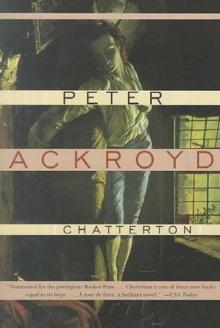 Chatterton
Chatterton The Canterbury Tales – A Retelling
The Canterbury Tales – A Retelling Alfred Hitchcock
Alfred Hitchcock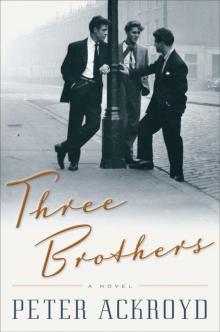 Three Brothers
Three Brothers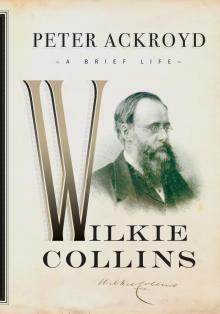 Wilkie Collins
Wilkie Collins Venice
Venice Poe
Poe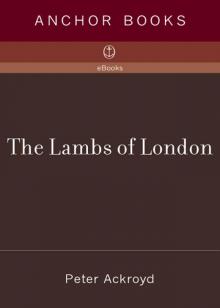 The Lambs of London
The Lambs of London London
London Queer City
Queer City Revolution, a History of England, Volume 4
Revolution, a History of England, Volume 4 Venice: Pure City
Venice: Pure City Foundation
Foundation Thames
Thames The Plato Papers
The Plato Papers The house of Doctor Dee
The house of Doctor Dee Rebellion: The History of England from James I to the Glorious Revolution
Rebellion: The History of England from James I to the Glorious Revolution Albion: The Origins of the English Imagination
Albion: The Origins of the English Imagination The Fall of Troy
The Fall of Troy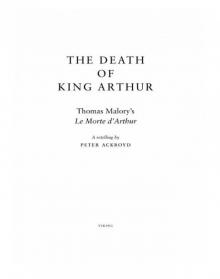 The Death of King Arthur
The Death of King Arthur The Trial of Elizabeth Cree
The Trial of Elizabeth Cree London: The Biography
London: The Biography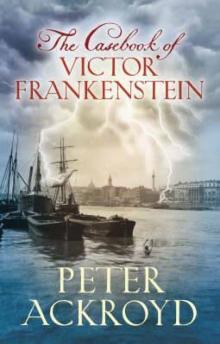 The Casebook of Victor Frankenstein
The Casebook of Victor Frankenstein Hawksmoor
Hawksmoor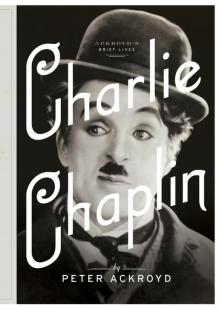 Charlie Chaplin
Charlie Chaplin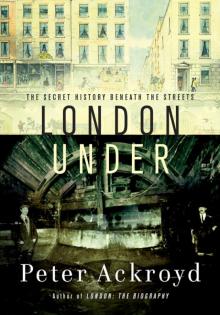 London Under
London Under